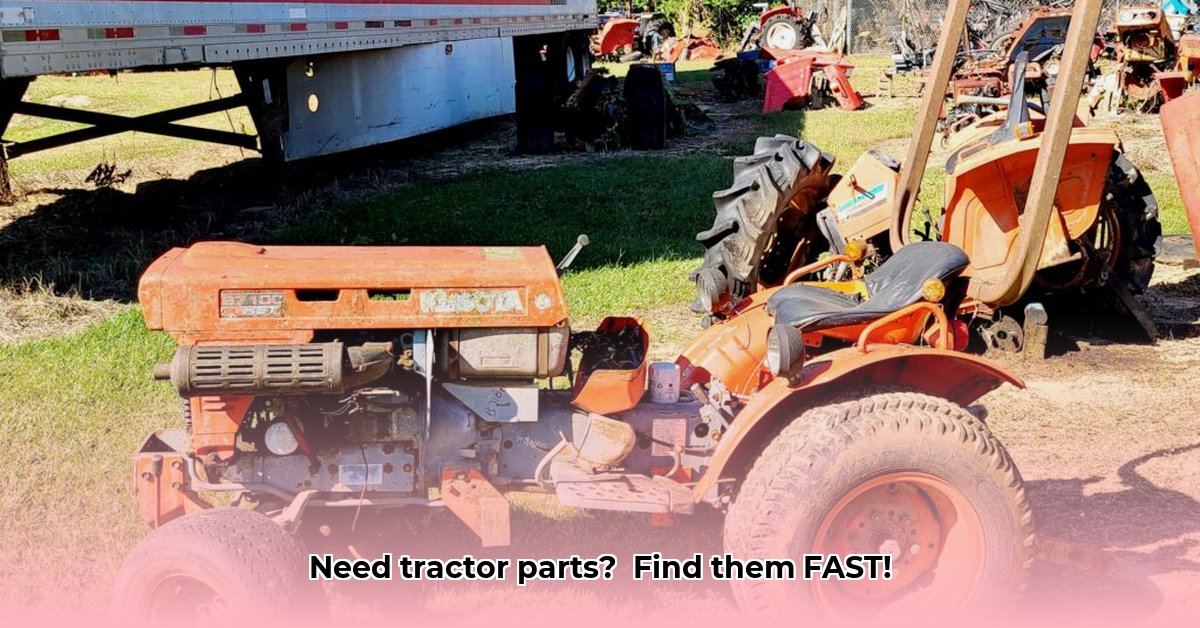
Finding the right tractor part quickly and affordably can be a challenge. Bowman's Tractor Salvage, operating in Central Indiana, offers a solution by providing used tractor parts, addressing the high cost of new equipment. This article analyzes their business model, market challenges, and strategies for success. We'll also examine how farmers and other equipment users can best navigate the used parts market. For more options, check out other tractor parts.
The Used Farm Equipment Market: A Dynamic Landscape
The market for used farm equipment is highly volatile. High new equipment costs drive demand for used parts, leading to a competitive landscape. Bowman's Tractor Salvage operates within this dynamic environment, presenting both opportunities and challenges. How can they maintain a competitive edge amidst fluctuating supply and demand? This requires a keen understanding of market forces.
Bowman's Tractor Salvage: Central Indiana Operations and Expansion
Bowman's Tractor Salvage benefits from its established Central Indiana presence, building strong local relationships. However, the high cost of transporting heavy parts limits immediate regional reach. To overcome this, they strategically leverage online marketplaces like eBay, extending their market to a national audience. This expansion, while beneficial, introduces new challenges in inventory management, pricing, and supply chain optimization. How effectively is Bowman's managing this growth?
Key Strategies for Success
Bowman's success stems from a multi-pronged strategy combining technology, relationships, and precise pricing.
Efficient Inventory Management: Modern digital tools ensure accurate tracking of stock levels, sales, and demand, preventing losses and streamlining operations. How is this data used to inform purchasing decisions?
Effective Online Marketing: A strong online presence, capitalizing on platforms such as eBay, significantly increases reach and attracts a national customer base. Is their digital marketing strategy aligned with their overall business goals?
Strategic Alliances: Collaboration with other businesses secures access to a steady supply of parts and provides additional distribution channels. Which key partnerships drive their success?
Data-Driven Pricing: Meticulous market research and competitor analysis ensure competitive pricing while maintaining profitability. What algorithms or models, if any, inform their pricing decisions?
Future Growth and Opportunities
Bowman's long-term success hinges on adaptation and innovation. Several avenues for growth are apparent:
Geographic Expansion: Partnerships with other salvage yards across a wider geographical area could significantly increase market reach and access to a larger customer base.
Inventory Diversification: Expanding the inventory to include parts from a broader range of tractor brands would attract a more diverse customer base.
Investment in Technology: Advanced diagnostic tools for part quality assessment would enhance customer satisfaction and reduce returns, fostering loyalty and positive word-of-mouth referrals.
Predictive Modeling: Implementing predictive modeling for pricing and order quantities would optimize efficiency and improve the bottom line.
Finding Affordable Tractor Parts: A Practical Guide
The search for the right tractor part can be frustrating. Bowman's provides a valuable service, offering quality used parts at competitive prices, combined with strong customer service. Their understanding of the local farming community and commitment to meeting their needs highlights their integral role in the agricultural sector.
Three Pivotal Points for Success:
- Mastering inventory management: Accurate tracking and forecasting are vital for profitability in this volatile market.
- Leveraging online platforms: Reaching a broader customer base requires a strong online presence and effective digital marketing.
- Building strategic partnerships: Collaboration with other businesses provides access to a wider range of parts and distribution channels.
How to Manage Inventory Effectively in the Used Agricultural Equipment Parts Market
The used agricultural equipment parts market presents unique challenges. Effective inventory management requires proactive strategies to balance supply and demand.
Strategies for Success
Accurate Data: Real-time inventory tracking (e.g., using barcode or RFID systems) provides precise information on stock levels and part condition.
Demand Forecasting: Analyzing sales data and market trends helps predict future demand, enabling strategic purchasing of high-demand parts.
Strategic Sourcing: Developing relationships with other salvage yards and suppliers diversifies sourcing options.
Part Grading and Condition Assessment: A transparent grading system builds trust and minimizes misunderstandings.
Efficient Storage and Organization: Proper warehouse organization ensures quick retrieval of parts.
Data-Driven Pricing: Market analysis enables competitive pricing while maintaining profitability.
Technological Solutions
Technology plays a crucial role in streamlining operations:
Online Inventory Management Systems: Cloud-based systems provide real-time updates, reducing errors and improving efficiency.
E-commerce Integration: An online store expands reach and accessibility.
Data Analytics: Analyzing sales data reveals trends, enabling better inventory control and pricing decisions.
The Just-In-Time (JIT) Approach: A Hybrid Model
While a full JIT model may be challenging due to parts availability, a hybrid approach focusing on high-demand parts can improve efficiency and reduce storage costs.